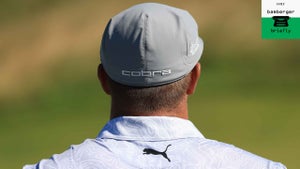As almost all golf fans know by now, Bryson DeChambeau approaches his game a little differently than other pros. To say he’s simply analytical is underselling the production.
No one knows this better than Tim Tucker, DeChambeau’s former caddie who was with him for eight victories, including the 2020 U.S. Open, before the two split up during the Rocket Mortgage Classic in early July.
Tucker recently joined GOLF’s Subpar Podcast with co-hosts Drew Stoltz and Colt Knost to talk about caddying for DeChambeau, why they parted ways, Tucker’s new venture with Bandon Dunes and more. But one of the most interesting takeaways was just how much data Tucker needs to supply DeChambeau before hitting a golf shot. Stoltz asked him to walk through all of the information he would need to give DeChambeau before he hit a typical shot from the fairway.
For the most part, we’ll let Tucker’s full quotes do the talking, because it’s enlightening stuff.
“Obviously the normal front [yardage], where the pin is, we do air density,” Tucker said. “So, every Monday we get his numbers. So there are no stock numbers for him. If you said, how far do I hit my 7 iron, he’d go, ‘What’s the air density?’ He doesn’t know. I don’t know. So we find that out on Monday. We always use two launch monitors to make sure we have the right swing speed, his stock swing speeds, and then we find out how far it is based on air density.”
This is where you are wondering what air density is, right? We thought so.
“So, air density, a lot of people don’t know this. Like here in Amarillo, Texas, I’m in 3,500 feet, and today it was 90 degrees; air density here was 6,800 feet,” Tucker said. “So if I were making adjustments off 3,500, I would be 7 percent off on my calculation. That’s just one aspect. So we make that adjustment when we get to the ball. I’ll say something like, it’s 175, with air density it’s 185. Then it is, what slope are we going to land into? Two percent slope, OK, green density is 5.8 millimeters. OK? Our spin rate with this club is X and it’s going to release 3 yards.”
Confused? Us too. Tucker said they first used this at the Travelers Championship four or five years ago, but it started before that when they were at a course in Naples, Fla. They noticed a superintendent dropping a metal ball on a green and measuring the dent it made on the green. They asked what he was doing, and he said it was to measure green density.
“And we were like, OK, cool, let’s do that and see if it correlates,” Tucker said.
During their next week off they flew to Fresno, Calif., and went around to every green on the golf course. They’d drop a ball, DeChambeau would hit a shot, and they’d measure the run out of the golf ball. Tucker kept track of this data in an excel spreadsheet.
“I’d say, hey, he had a 178-yard shot, landing into 2 percent slope, wind at a 45 degree angle down at 10 mph, and it rolled out X,” Tucker said. “I just kept putting those in after every round and for a year we did that and we’d just push sort and got a baseline. So our baseline is based on a 2 percent slope, no wind.”
To find the green density at tournaments, Tucker’s work usually started on Mondays. He’d take a golf ball and drop it at likely pin locations on every green, and then he’d go to the putting green and drop a ball in two more locations. He’d monitor them throughout the week and chart it in millimeters. Since he wouldn’t be able to drop more balls on the tournament holes after the event started, he’d drop them in the same two spots on the putting green and see if there was any change.
“So if it rained overnight and it was super soft, let’s say it was .58 (millimeters), or 580” — as Tucker and DeChambeau called it — “today it might be 680, so that’s a considerable change in the green, so I’m assuming the rest of the greens are that way and that correlation works really well.”
And this works? Yes, Tucker said. He used the 10th hole at the Safeway Open in Napa, Calif., as an example.
“The front of the green is .45 millimeters green density — we call it 450 — but middle-right pin was 800, super soft, so if you hit a 4-iron it would hit a pitch mark and stay,” Tucker said. During the first round one year, everyone hit to about 12 feet, while DeChambeau tried to land it at the pin because they knew it was soft. “The next day, I’m like, Bryson, green density is 450 here, we just need to land it on the front, and we did, while everyone else in the group threw it at the pin again, because yesterday it didn’t roll out any, and they had 40-45 footers, and Bryson had a 15 footer. In those situations it is super important to know what that landing area is on that quadrant of the green.”
And here you thought counting off your yardage from a sprinkler head was hard work? You can watch Tucker’s full Subpar interview below.

